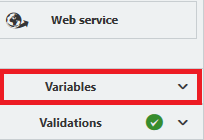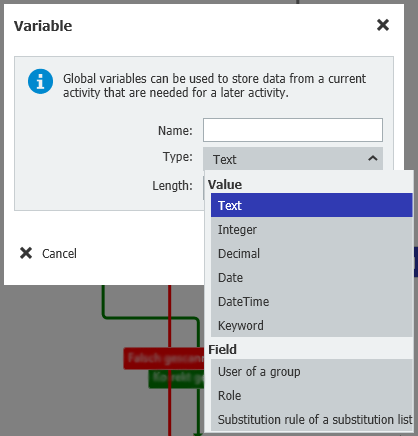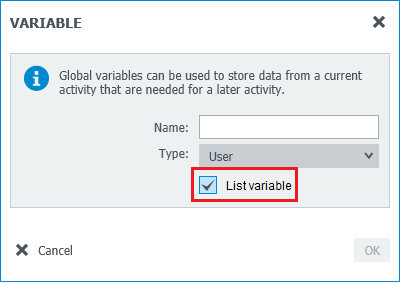Do you use variables in your workflows? These placeholders are filled with specific values – like a date or an invoice number – that are used multiple times within your workflows.
In Workflow Designer, you can set up your variables to draw on values (for example, from a document’s data) so that they can be used over and over again. Think of variables as placeholders, caches, or containers. You simply give the variable a name and specify the value with which it should be filled. You can then use these variables or values in workflow steps.
To set up variables, click on the button in the activity bar in Workflow Designer.

For example, you can save the first user of a workflow as your variable. Let's say you set up a workflow for a contract release process. When all approval steps have been completed, the task should be reassigned to the user who started the process. In the assignment at the end of the workflow, you therefore add the "first user" variable.
Here are some other ideas for boosting your efficiency by using variables:
- Registration Form with Email Address. Set up a workflow to register employees for a company outing. The value from the field "email address" will be used in other stops along the workflow. You can therefore create a variable of the same name and assign it, using the email address from the file cabinet/index field. In the workflow task "Email," you set the variable as a recipient’s email.
- Supplement Customer Data. For an invoice, you have entered the customer number in a workflow task’s form. You can now capture the name of the customer from an external database and have it written into a variable. In this way it can be reused in other workflow steps.
- Assigning Responsibilities As soon as an invoice amount exceeds a certain time limit, another colleague can be selected as a “substitute” to approve it. In an external table, you can maintain user name, representative, and approval parameters. The user‘s name is then used to read out the appropriate values from this external table and to write them to the variables.
- Calculate Reminders for Payment Schedule. For supplier invoices, write the deadline as the due date in a variable as part of your invoice workflow. To ensure timely payment, use another variable to calculate dynamic reminder dates – such as 14 days before the due date. In an arithmetic expression (Visual Basic), simply subtract this number of days from the deadline variable.
- Enter Registration Deadline. Similar to a payment deadline, you can set up a registration deadline for an event workflow. Let’s say you want to have a registration deadline calculated three days before the event date. For the registration deadline you create a date variable. Using an arithmetic expression, subtract three days from the event date to calculate the registration deadline.
More on Variables…
There are different types of variables, for example, for text or data. When you create the variable, simply select the appropriate type.

You can also assign tasks to multiple users, roles or substitution lists by using a list variable. Here’s the option you’ll activate for this:

In order to use variables most efficiently in workflows, it helps to understand the basic difference to index data. Variables depend on a workflow instance. In contrast, index data is linked to the stored document.

